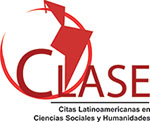Pathways to internationalization in agronomy: institutional strategies and challenges from a regional perspective
DOI:
https://doi.org/10.23857/dc.v11i2.4370Palabras clave:
Pathways to internationalization, agronomy, institutional strategiesResumen
The internationalization of higher education has become a critical component in preparing professionals for a globalized world. This article explores the pathways adopted by a regional public university in Ecuador to internationalize its Agronomy degree program. Through an institutional analysis, the study identifies key strategies including the integration of foreign language instruction, cross-border academic cooperation, and the alignment of curricular components with international standards. Despite structural and geographic limitations, the program has made progress in embedding internationalization through academic flexibility, student engagement in collaborative projects, and initiatives to strengthen digital and intercultural competencies. The article highlights the importance of coordinated institutional planning, external partnerships, and responsive policy frameworks in advancing internationalization in regional contexts. The findings contribute to a broader understanding of how agricultural education can evolve to meet global challenges while remaining rooted in local realities.
Citas
Acker, D. G. (2007). Globalizing agricultural colleges and universities: A guide to strategy and implementation. Association of Public and Land-Grant Universities (APLU).
Altbach, P. G., & Knight, J. (2007). The internationalization of higher education: Motivations and realities. Journal of Studies in International Education, 11(3-4), 290–305. https://doi.org/10.1177/1028315307303542
Beelen, J., & Jones, E. (2015). Redefining internationalization at home. In A. Curaj, L. Matei, R. Pricopie, J. Salmi, & P. Scott (Eds.), The European higher education area (pp. 59–72). Springer. https://doi.org/10.1007/978-3-319-20877-0_5
Bernasconi, A. (2018). Latin American universities and the Bologna Process: From cooperation to convergence? European Journal of Education, 53(4), 552–566. https://doi.org/10.1111/ejed.12311
Brandenburg, U., & de Wit, H. (2011). The end of internationalization. International Higher Education, (62), 15–17. https://doi.org/10.6017/ihe.2011.62.8533
Consejo de Educación Superior (CES). (2022). Reglamento de Régimen Académico. https://www.ces.gob.ec
de Wit, H., Hunter, F., Howard, L., & Egron-Polak, E. (2015). Internationalisation of higher education. European Parliament, Directorate-General for Internal Policies. https://doi.org/10.2861/444393
Egron-Polak, E., & Hudson, R. (2014). Internationalization of higher education: Growing expectations, fundamental values. International Association of Universities.
FAO. (2014). Education for rural transformation: Good practices in the non-formal education sector. Food and Agriculture Organization of the United Nations. https://www.fao.org
Hudzik, J. K. (2011). Comprehensive internationalization: From concept to action. NAFSA: Association of International Educators. https://www.nafsa.org
Knight, J. (2004). Internationalization remodeled: Definition, approaches, and rationales. Journal of Studies in International Education, 8(1), 5–31. https://doi.org/10.1177/1028315303260832
Knight, J. (2008). Higher education in turmoil: The changing world of internationalization. Sense Publishers.
Marginson, S., & Rhoades, G. (2002). Beyond national states, markets, and systems of higher education: A glonacal agency heuristic. Higher Education, 43(3), 281–309. https://doi.org/10.1023/A:1014699605875
Yin, R. K. (2014). Case study research: Design and methods (5th ed.). Sage Publications.
Zgaga, P., Teichler, U., & Brennan, J. (2013). The globalisation challenge for European higher education: Convergence and diversity, centres and peripheries. Peter Lang.
Descargas
Publicado
Cómo citar
Número
Sección
Licencia
Derechos de autor 2025 Marienny Barroso Leyva, Lucy Marina Pazmiño Calero, Elsa Amalia Basantes Arias

Esta obra está bajo una licencia internacional Creative Commons Atribución 4.0.
Authors retain copyright and guarantee the Journal the right to be the first publication of the work. These are covered by a Creative Commons (CC BY-NC-ND 4.0) license that allows others to share the work with an acknowledgment of the work authorship and the initial publication in this journal.






